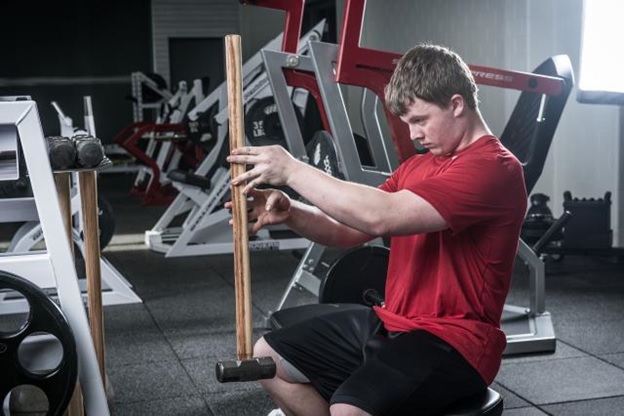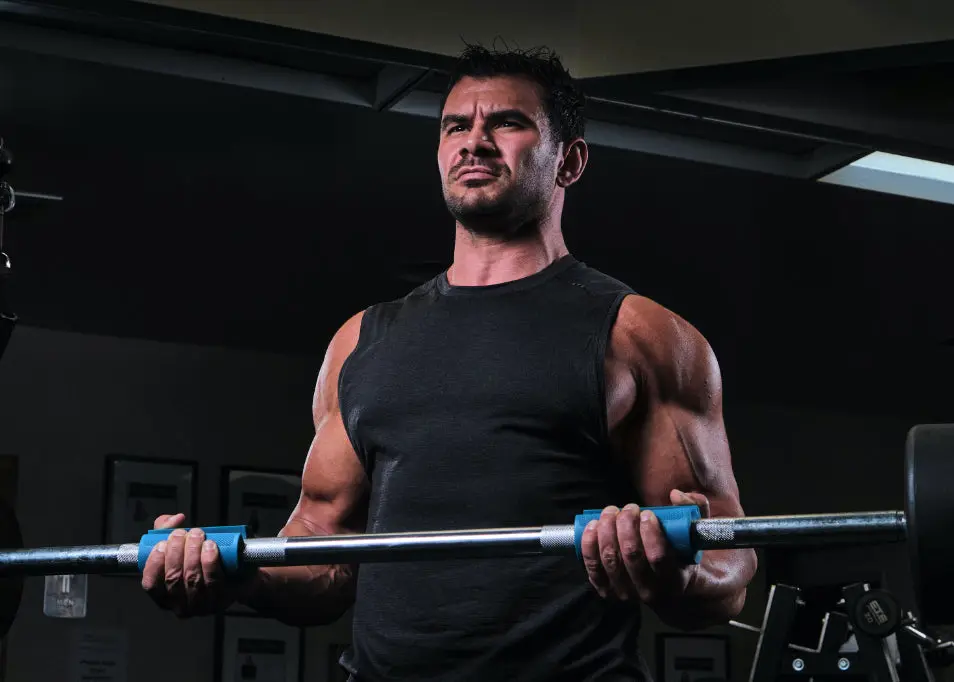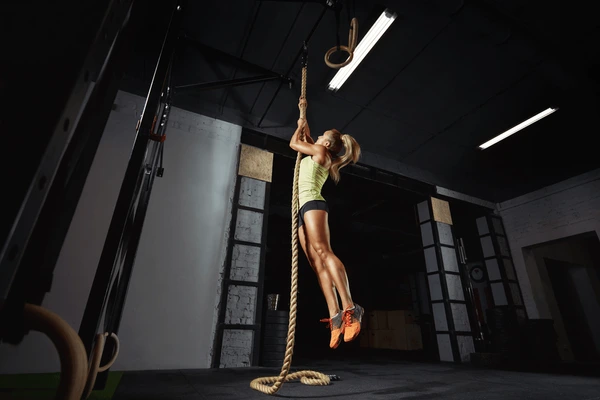Sledgehammer Levering (Wrist Lever Training for Forearm Power & Stability)
The Old-School Secret to Functional Forearm Strength and Control
Before machines and cable attachments, strength athletes built monster forearms and iron wrists with the simplest of tools — a sledgehammer.
What started as a laborer’s movement evolved into a legendary old-school exercise for developing forearm power, grip endurance, and wrist stability that carries over to everything from curls to heavy presses and combat sports.
Sledgehammer levering (also called wrist levering or leverage lifting) isolates and strengthens the small but crucial muscles of the forearm, wrist, and hand. It trains not just brute strength, but control — the ability to resist and stabilize torque under uneven load.
For bodybuilders, it’s a hidden gem for developing dense, corded forearm muscle, improving wrist integrity, and boosting performance in any lift that demands grip stability — from curls and deadlifts to pressing movements.
In this explainer, you’ll learn exactly how to perform and program sledgehammer levering for maximum forearm gains and bulletproof wrists.
Muscles Worked
Primary Muscles:
- Forearm Flexors – control downward movement and stabilize the handle.
- Forearm Extensors – resist and reverse the hammer’s motion.
- Pronator Teres and Supinator – rotate the forearm during controlled twists.
- Brachioradialis – assists with stabilization and lever control.
Secondary Muscles:
- Grip and Finger Flexors – maintain hold on the handle.
- Deltoids and Trapezius – stabilize shoulder and arm position.
💡 Levering hits the small stabilizers most other exercises miss, giving you strength that looks and feels “old-school functional.”
What Is Sledgehammer Levering?
Sledgehammer levering involves controlling the movement of a hammer, mace, or leverage bar through different ranges of motion using only your wrists and forearms.
Because the load is far from your hand (at the end of the long handle), it creates torque resistance, forcing the forearm muscles to stabilize dynamically.
Think of it as resistance-band training for your wrist — except it’s raw, real, and brutally effective.
Equipment Needed
- A sledgehammer (start with 4–8 lb for beginners, up to 20 lb for advanced lifters).
- Optional alternatives: Macebell, Clubbell, or Adjustable Lever Bar.
- A stopwatch or timer (for holds).
- Wrist wraps are optional but not required — the goal is to strengthen the wrists naturally.
How to Perform Sledgehammer Levering
There are several variations depending on the direction of motion. The two main patterns are wrist pronation/supination (rotating the forearm) and wrist flexion/extension (bending up and down).
Let’s go step-by-step through the foundational version:
- Front Lever (Wrist Flexion Focus)
Setup:
- Stand or sit holding a sledgehammer vertically in front of you, hammerhead pointing up.
- Grip the end of the handle with one hand.
- Tuck your elbow tightly into your side for stability.
Execution:
- Slowly lower the hammerhead forward toward the floor by bending at the wrist.
- Stop just before losing control or letting the hammer drop.
- Reverse the motion by flexing your wrist to return the hammer upright.
- Maintain full control throughout.
Sets/Reps: 3–4 sets of 8–10 reps per side.
- Reverse Lever (Wrist Extension Focus)
Setup:
- Hold the hammer vertically again, hammerhead up, same grip.
- Begin with your wrist flexed slightly forward.
Execution:
- Slowly lower the hammer backward by extending your wrist.
- Stop before your forearm disengages.
- Bring it back upright by flexing forward.
Sets/Reps: 3–4 sets of 8–10 reps.
- Side Lever (Pronation/Supination Focus)
Setup:
- Hold the hammer horizontally in front of you, elbow bent at 90°.
- Keep your forearm parallel to the floor.
Execution:
- Rotate your wrist so the hammer moves side to side in a controlled arc.
- Alternate directions for pronation and supination work.
- Keep your elbow locked in place — movement comes only from the wrist.
Sets/Reps: 2–3 sets of 10 rotations per direction.
- Lever Holds (Isometric Strength)
Setup:
- Hold the hammer at arm’s length, hammerhead parallel to the floor.
Execution:
- Maintain the position for 20–40 seconds without letting the hammer drop.
- Keep wrists neutral and forearms tight.
Sets: 3–5 holds per side.
🧠 Isometric holds are incredible for developing endurance and joint resilience.
Why Sledgehammer Levering Works
- Creates Torque Resistance – Forces your wrist to resist leverage instead of simple load.
- Strengthens Stabilizers – Engages deep forearm muscles and tendons.
- Improves Grip & Wrist Control – Builds strength that directly transfers to lifting performance.
- Develops Balanced Forearm Strength – Works flexors, extensors, and rotators equally.
- Boosts Tendon Durability – Reduces risk of wrist and elbow pain from repetitive lifting stress.
Programming Guidelines
For Hypertrophy (Muscle Size & Density)
- Sets/Reps: 3–4 sets of 10–12 reps.
- Load: Light-to-moderate hammer for strict control.
- Tempo: 2–3 seconds up, 3–4 seconds down.
- Rest: 45–75 seconds between sets.
For Strength & Stability
- Sets/Reps: 3 sets of 6–8 controlled reps.
- Hold Variations: Include static holds of 20–30 seconds.
- Rest: 90 seconds between sets.
For Grip Endurance (Functional Focus)
- Duration: 3 rounds of 30–45-second holds or rotations.
- Goal: Maintain position under fatigue.
- Rest: 60 seconds between rounds.
Training Strategies from a Bodybuilder’s Perspective
💪 1. Use It as a Finisher
After curls or reverse wrist curls, perform 2–3 sets of levering for pure forearm exhaustion and pump.
💪 2. Rotate Movement Patterns
Alternate between flexion/extension and pronation/supination each session for balanced development.
💪 3. Prioritize Control Over Load
Leverage training is about precision — swinging the hammer defeats the purpose.
💪 4. Build Gradually
Move your hand an inch closer to the hammerhead as you progress — the shorter the lever, the heavier it feels.
💪 5. Incorporate Holds Weekly
Static holds reinforce stability and tendon strength that carries over to every lift.
Common Mistakes & Fixes
| Mistake | Problem | Fix |
| Using too heavy a hammer | Loss of control and wrist strain | Start light — focus on smooth movement |
| Moving from the elbow | Removes wrist tension | Keep elbow locked to isolate wrist |
| Rushing the movement | Reduces effectiveness | Slow down both lowering and raising phases |
| Skipping opposite directions | Creates imbalance | Always train both flexion and extension |
| Poor wrist alignment | Increases injury risk | Keep wrist neutral — avoid over-bending |
Integration Into a Program
Example “Forearm Finisher” Workout:
- Barbell Wrist Curl – 3×12–15
- Reverse Curl – 3×10–12
- Sledgehammer Levering (Front + Reverse) – 3×8 each direction
- Lever Hold – 3×30s each arm
- Finger Extensions – 3×20
Frequency:
- 2–3 times per week (allow 48 hours between sessions).
- Ideal as the final segment of upper-body or arm training days.
Benefits Beyond Bodybuilding
Even though sledgehammer levering is perfect for physique training, it also benefits:
- Powerlifters & Strongmen: Reinforces grip integrity for deadlifts and carries.
- Martial Artists & Fighters: Improves wrist stability for striking and grappling.
- Manual Workers & Climbers: Enhances functional hand endurance and dexterity.
🧱 In short, this is real-world strength training — the kind of power that shows up both in the gym and in life.
Safety Tips
⚠️ Start with a light hammer — control is more important than weight.
⚠️ Don’t overtrain; wrist tendons fatigue quickly.
⚠️ If you feel pain (not fatigue), stop immediately and stretch.
⚠️ Maintain a neutral wrist — avoid extreme bending.
⚠️ Train both hands equally to prevent imbalances.
Recovery & Maintenance
Since levering heavily taxes small stabilizers, prioritize recovery:
- Stretch wrists and forearms after each session.
- Perform slow rotations to release tension.
- Massage with a lacrosse ball or forearm roller.
- Contrast soak (warm/cold water) for joint relief if needed.
Practical Takeaways
✅ Sledgehammer levering is the ultimate old-school tool for wrist and forearm development.
✅ Builds torque strength and joint stability that machines can’t replicate.
✅ Use controlled tempo and light load — power comes from precision.
✅ Train 2–3 times weekly for balanced strength and hypertrophy.
✅ Expect forearms that look — and perform — like forged steel.
Conclusion
Sledgehammer levering takes you back to the roots of strength — simple, raw, and brutally effective. It builds dense, functional muscle while bulletproofing your wrists for the heavy lifting that follows.
In an age of machines and cable stacks, this exercise stands as a reminder: true forearm power comes from control, not complexity.
Whether you’re chasing aesthetic forearms, a stronger grip, or wrist resilience that lasts a lifetime, levering should be in your arsenal.
Train it consistently, respect the form, and you’ll develop the kind of iron wrists and thick forearms that define real lifters.





